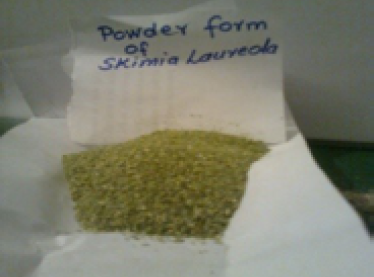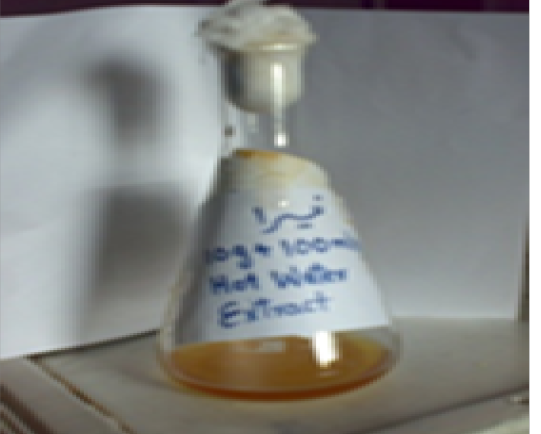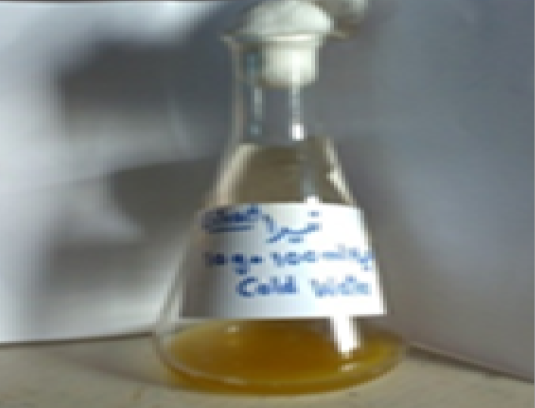Advances in Pharmaceutical and Ethnomedicines
Research Article
Antibacterial Activity of Aqueous Extracts of Skimmia laureola
Muhammad Aurang Zeb1, Abdul Halim1*, Muhammad Sajid1, Khanzadi Fatima Khattak2, Taj Ur Rahman2, Saadat Ullah Khan1, Salim Ullah1
1Department of Biochemistry, Hazara University, Mansehra, Khyber Pakhtunkhwa, Pakistan; 2Department of Chemistry, Abdul Wali Khan University, Mardan, Khyber Pakhtunkhwa, Pakistan.
Abstract | The aim of this research work was to evaluate the antibacterial activity of Skimmia laureola against various pathogenic strains of bacteria. The hot and cold water extracts of the plant were tested against four bacterial strains namely Escherichia coli, Bacillus subtilus, Staphylococcus aureus and Proteus mirabilis. Antibacterial activity was conducted by agar well diffusion method. The Skimmia laureola leaves extracts showed different levels of antibacterial activity against the tested strains. The aqueous extracts showed antibacterial activity against the micro-organism but not too maximum.
Keywords | Medicinal plants, Skimmia laureola, Hot water extraction, Cold water extraction, Antibacterial activity
Editor | Mayada Ragab Farag, Forensic Medicine and Toxicology Department, Faculty of Veterinary Medicine, Zagazig University, Zagazig, Egypt.
Received | June 16, 2016; Accepted | August 02, 2016; Published | August 15, 2016
*Correspondence | Abdul Halim, Department of Biochemistry, Hazara University, Mansehra, Khyber Pakhtunkhwa, Pakistan; Email: abdulhalimbiochemist@gmail.com
Citation | Zeb MA, Halim A, Sajid M, Khattak KF, Rahman TU, Khan SU, Ullah S (2016). Antibacterial activity of aqueous extracts of Skimmia laureola. Adv. Pharm. Ethnomed. 3(1): 19-22.
DOI | http://dx.doi.org/10.14737/journal.ape/2016/3.1.19.22
ISSN | 2310-0575
Copyright © 2016 Zeb et al. This is an open access article distributed under the Creative Commons Attribution License, which permits unrestricted use, distribution, and reproduction in any medium, provided the original work is properly cited.
INTRODUCTION
The medicinal plant botanically classified as Skimmia laureola DC. Decne (Rutaceae) is ascented shrub dispersed from Northern China to the Himalayas; its leaves give off a musky smell when crushed/powdered. Customarily, the plant is used in both folk and cultural practices: the smoke of parched leaves is considered useful to ward off troubles (Hamayun, 2007) and leaves are arranged in garlands and considered sanctified (Bhattarai et al., 2006). In traditional system of medication the leaves are employed as an antitussive and as a veterinary anthelmintic, insecticide and pesticide, when dried and crushed. The dried leaves smoke is used to clear the nasal tract and for cold, fever and headache treatment (Qureshi et al., 2009). Earlier phytochemical studies revealed the composition of the essential oil from S. laureola from different areas (Shah et al., 2003, 2013a, 2013b; Jangwan et al., 2010; Mathela et al., 1992). Other phytochemical like Triterpenoids (Sultana and Sultana, 2009; Atta-ur-Rahaman et al., 2006), alkaloids and coumarins have also been reported (Sultana et al., 2004) from the plant. The essential oil extracted from the plant has been tested for both its antimicrobial and insect-repellent bioassays (Shah et al., 2003; Jangwan et al., 2010; Mehmood et al., 2012), and for anti-nociceptive, acute toxicity, antipyretic and anticonvulsant properties (Muhammad et al., 2013). The alkaloids belongs to quinoline class have been isolated from S. laureola exhibited cholinesterase inhibiting and calcium blocking properties (Atta-ur-Rahman et al., 2006) and tyrosinase inhibiting activity (Sultana et al., 2005). Various extracts of the plant have demonstrated antinociceptive and antipyretic (Barkatullah et al., 2013), antifungal (Ahmad and Sultana, 2003) and mutagenic activities (Riazzudin et al., 1987). S. laureola are important source of potentially useful structures for the development of new chemotherapeutic agents. The first step towards this goal is the in vitro antibacterial activity assay (Tona et al., 1998). Many reports are available on the antiviral, antibacterial, antifungal, anthelmintic, antimolluscal and anti-inflammatory properties of plant. Some of these observations have helped in identifying the active principle responsible for such activities and in the developing drugs for the therapeutic use in human beings. The aim of this research work was to evaluate the antibacterial activity of S. laureola plant against various pathogenic strains of bacteria.
Materials and Methods
Plant Materials
S. laureola plant were obtained from Pansar Store near Lari Adaa, Mansehra. The plant was identified at the Department of Botany, Hazara University Mansehra, Pakistan.
Preparation of Plant Extracts
The plant was dried at sunlight and then plant were crushed into coarse powder using grinder and then stored in clean, dried plastic bags for further processing. From powder about 20 g was taken for experimental use to prepare plant extracts (Figure 1).

Figure 1: Powder form of Skimmia laureola
Cold water extraction: A total of 10 g powder of S. laureola plant was soaked in 100 ml of cold distilled water and shaken it on electric rotator at 200 rpm for 24 hours. After 24 hours the solution was filtered through a filter paper then centrifuged at 4400 rpm for 7 minutes and repeat it 3 times the supernatant appeared at top was collected which was considered as 100% pure plant extract while the pellet appeared at bottom of centrifuge tubes was discarded the pure extract were then ready for antimicrobial sensitivity test (Figure 2).
Hot water extraction: S. laureola (10 g) plant was soaked in 100 ml distilled water in a conical flask and then it placed in the incubator at 37 ºC for 12 hours after this it was placed in the hot water bath (65 ºC) for 2 hours and then centrifuge it for 7 minutes at 4400 rpm then filtered it through filter paper and repeated this process for 3 times the supernatant obtained from 3rd time centrifugation collected while pellet were discarded and this was considered as a pure hot extract of these plants and these were ready for sensitivity tests (Figure 3).

Figure 3: Hot water extraction of Skimmia laureola
Antimicrobial Assay
Nutrient agar (20 g)was dissolved in 1 litter of distilled water in a conical flask and 4 g of simple agar is also added and plugged in flask and shake to mix well. Then it is heated on the hot plate stirrer to dissolve the media completely. The media and all glass ware swabs were sterilize by means of autoclaving under the 15 psi and 121 degree centigrade temperature for 15 minutes in autoclave. After this media was poured aseptically into Petri dishes in laminar flow cabinet. Media which was prepared and autoclaved was smeared or spread on the Petri dishes in laminar flow cabinet. The Electric fan of laminar flow cabinet was turned on to solidify the media and the pores are made in Petri dishes containing media by tips in laminar flow cabinet. Then the sterilized cotton swab was dipped in the distilled water and then dipped in the bacterial culture placed it on the Petri dish containing media in order to streak culture on the surface of nutrient agar media of Petri dish uniformly. One cotton swab is used for only once streaking of one Petri dish then discarded (cotton swab). Poured the hot and cold water extracts of plants in the well in media of Petri dish by micro pipette of 100 ml. After pouring all plates or Petri dishes were incubated in electric oven or incubator for about 24 hours at 37ºC and then antibacterial activity was checked. The zone of inhibition was measured by scale in mm after 24 hours the antibacterial activities were assigned according to the zone of inhibition produced by the plant extracts. Iimipenem was used as standard antibiotics.
Results and Discussion
In the present research project the antibacterial activity of the hot and cold water extract of S. laureola were checked against four bacterial strains. These strains included Staphylococcus aureus, Escherichia coli, Proteus mirabilis and Bacillus subtilis. The inhibitory activity which were shown by cold and hot water extracts against the micro-organisms (Table 1 and 2). In cold water extract of Skimmia leureola shows no activity against E.coli, while 10 mm activity showed against B. subtilus, 11 mm against S. aureus and 10 mm against P. mirabilis.
Table 1: Hot water extraction of Skimmia leureola
|
Micro-Organism |
Imipenem (Standard drug) |
Triplicate measurement Zone of inhibition (mm) |
Mean |
||
|
Escherichia coli |
37 |
11 |
13 |
11 |
12 |
|
Bacillus subtilus |
36 |
13 |
15 |
14 |
14 |
|
Staphylococcus aureus |
41 |
20 |
20 |
19 |
20 |
|
Proteus mirabilis |
87 |
ND |
ND |
ND |
ND |
ND: Not Detected; Hot water extract of Skimmia leureola showed 12 mm zone of inhibition against E. coli, 14 mm against B. subtilus and 20 mm against S. aureus; While, no activity was detected against P. mirabilis
Table 2: Cold water extraction of Skimmia leureola
|
Micro-Organism |
Imipenem (Standard drug) |
Triplicate measurement Zone of inhibition (mm) |
Mean |
||
|
Escherichia coli |
35 |
ND |
ND |
ND |
ND |
|
Bacillus subtilus |
38 |
10 |
9 |
11 |
10 |
|
Staphylococcus aureus |
41 |
11 |
10 |
12 |
11 |
|
Proteus mirabilis |
89 |
10 |
10 |
9 |
10 |
ND: Not Detected
conclusion(s)
In the ongoing phytochemical studies leaves extracts obtained both in cold and hot water was tested against various strains of bacteria to test their antibacterial potency. Antibacterial activity was performed by agar well diffusion method. The data obtained revealed that the leaves extracts of Skimmialaureola displayed different levels of activity against these tested strains. The aqueous extracts exhibited antibacterial activity against these micro-organism but not too maximum.
Acknowledgments
Authors are grateful to the Chairman Department of Biochemistry, Hazara University, Mansehra, KPK, Pakistan for providing research facilities.
Conflict of Interest
We declare that we donot have competing of interest.
Authors’ contrbution
All the authors contributed equally.
REFERENCE






